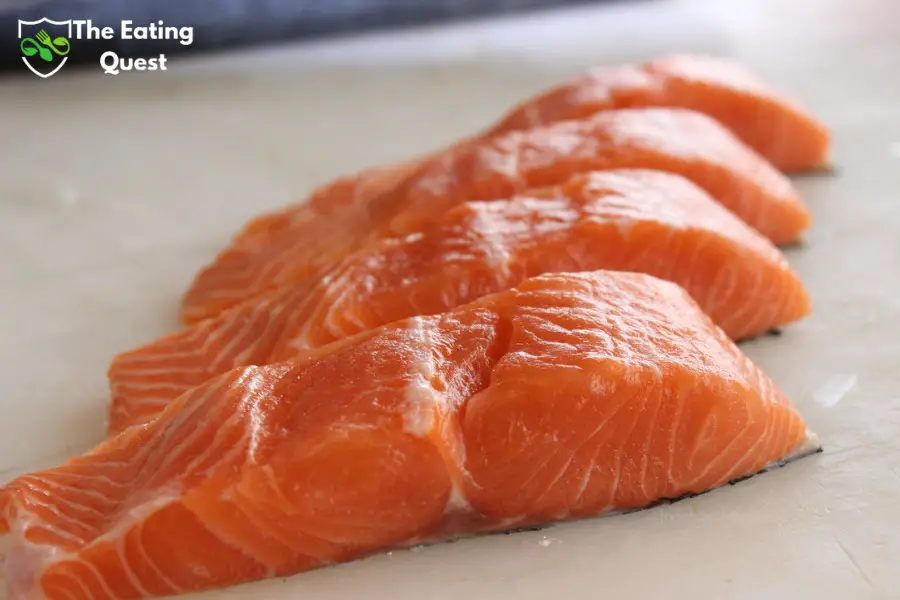If you’re a salmon fan, you may wonder how long it lasts in the fridge. Whether you have leftovers from dinner or want to store fresh salmon, it’s essential to know how to properly keep it to ensure it stays fresh and safe to eat.
According to the USDA, the good news is that Fresh salmon can last in the fridge for up to 2 days. However, Raw salmon has a shorter shelf life and will only stay fresh for about 2-3 days in your fridge or until the best-by date on the package. To extend the freshness of your salmon, it’s essential to store it properly in an airtight container and keep it at the right temperature.
How Long Does Fresh Salmon Last in the Fridge?
Factors that Affect Salmon Freshness
When it comes to fresh salmon, its shelf life depends on several factors, including the quality of the fish, the temperature at which it is stored, and how it is handled. Fresh salmon that is properly stored can last for up to 4 days in the fridge. However, if it is not stored correctly, it can spoil quickly, leading to foodborne illness.
The Shelf Life of Fresh Salmon
The shelf life of fresh salmon can be affected by several factors. One of the most critical factors is temperature. Fresh salmon should be stored in the fridge at a temperature of 40°F or below. Anything above this temperature can cause the fish to spoil quickly. It is also important to store fresh salmon in an airtight container or wrapped tightly in plastic wrap to prevent air exposure.
Another critical factor affecting fresh salmon’s shelf life is how it is handled. If fresh salmon is mishandled during processing or transportation, it can lead to bacterial growth and spoilage. It is best to purchase fresh salmon from a reputable source and handle it carefully to ensure its freshness.
In summary, fresh salmon can last up to 4 days in the fridge if stored correctly. To ensure the most extended possible shelf life, store fresh salmon at a temperature of 40°F or below in an airtight container or wrapped tightly in plastic wrap. Proper handling and purchasing from a reputable source can also help extend the shelf life of fresh salmon.
How to Store Fresh Salmon in the Fridge
The Best Way to Store Fresh Salmon
When it comes to storing fresh salmon in the fridge, there are a few things you need to keep in mind to ensure that it stays new and safe to eat. The best way to store fresh salmon is to wrap it tightly in plastic or aluminum foil to prevent air from getting in. This will help keep the fish moist and prevent drying out.
The Importance of Proper Handling
Proper handling is also crucial when storing fresh salmon in the fridge. Always handle the fish gently to avoid damaging the delicate flesh. Keep the salmon in the coldest part of the fridge, usually at the back, to help maintain its freshness.
The Benefits of Airtight Containers
Airtight containers are another great way to store fresh salmon in the fridge. These containers help to keep the fish fresh by preventing air from getting in and causing it to dry out. Airtight containers also help to prevent the salmon from absorbing any unwanted odors from other foods in the fridge. Storing fresh salmon in the fridge is a great way to keep it fresh and safe. By following these tips and using suitable storage methods, you can help maintain the freshness and texture of the fish while ensuring its safety.
Why Proper Salmon Storage is Important
When it comes to storing salmon, proper storage is crucial to ensure its freshness and prevent foodborne illness. Here are the reasons why adequate salmon storage is essential:
The Dangers of Improper Storage
Improper storage of salmon can lead to the growth of bacteria that can cause food poisoning. Scombroid poisoning is one of the most common types of food poisoning associated with salmon. This type of food poisoning is caused by the buildup of histamine in the flesh of the fish due to improper storage or handling.
Consuming salmon that has not been stored properly can result in symptoms such as itching, headaches, nausea, and vomiting. In severe cases, it can even lead to hospitalization.
By following proper storage guidelines, you can ensure that your salmon stays fresh and safe to eat.

How to Tell if Salmon Is Bad?
Salmon is a delicious and healthy fish that can be enjoyed in many ways. However, it can go well quickly if careful, and eating spoiled salmon can lead to food poisoning. Here are some signs to look out for to determine if your salmon has gone bad.
Signs of Spoiled Salmon
The first thing to look for is the color. Fresh salmon should be pink or orange, but if it’s gray or brown, it’s a sign that it has gone bad. Another sign of spoiled salmon is a strong, unpleasant odor. Fresh salmon should have a mild, ocean-like smell, but it’s no longer safe to eat if it smells stinky or like ammonia.
If you notice any mold on the salmon, it’s time to discard it. Mold can cause various health problems, and it’s not something you want to mess around with.
When to Discard Leftover Salmon
Knowing when to throw it away is essential if you have leftover salmon. According to the USDA, raw salmon is good for up to two days in the refrigerator, while cooked salmon should be consumed within three to four days. If you need to figure out how long your salmon has been in the fridge, it’s better to err on caution and throw it out.
How to Safely Reheat Salmon
If you’re planning to reheat leftover salmon, it’s essential to do so safely. Make sure to heat it to an internal temperature of 145°F (63°C) to kill any bacteria that may have grown. You can use a microwave, oven, or stovetop to reheat your salmon, but do so slowly and evenly to avoid overcooking or drying it out.
By watching for these signs and following proper storage and reheating guidelines, you can enjoy delicious and safe salmon for days to come.
Can You Freeze Salmon?
If you have a lot of salmon on your hands and need help with what to do with it, freezing is a great option. However, you should know the pros and cons of freezing salmon before you do it.
The Pros and Cons of Freezing Salmon
One of the main advantages of freezing salmon is that it allows you to store it for longer. If you have a lot of salmon, you won’t be able to eat it immediately; freezing it can help prevent it from going bad.
However, there are some downsides to freezing salmon as well. One of the biggest concerns is the texture of the meat. When you freeze salmon, ice crystals can form inside the fish, damaging the texture and making it less enjoyable to eat. Also, freezing salmon can affect its health benefits, as some nutrients can be lost during freezing.
How to Freeze Salmon
If you decide to freeze your salmon, there are a few things you should keep in mind. First, ensure the salmon is as fresh as possible before freezing it. This will help preserve the texture and flavor of the fish.
Next, wrap the salmon tightly in plastic or aluminum foil to prevent air from getting in. You can also place the salmon in a sealable plastic bag to help prevent freezer burn.
When ready to use the frozen salmon, you must thaw it first. The best way to do this is to place it in the refrigerator and let it thaw slowly overnight. This will help preserve the texture of the fish and prevent it from becoming mushy.
Overall, freezing salmon can be a great way to store it for later use. Just be aware of the potential downsides and take steps to minimize any adverse effects on the texture and health benefits of the fish.
Conclusion
If you’re wondering how long salmon last in the fridge, the answer is up to 3 days after it has been cooked. However, the freshness of the fish before cooking is a crucial factor in determining how long it will last. If the fish is fresh and in good condition before cooking, it can last up to 3 days in the fridge.
Raw salmon, on the other hand, should be eaten within 3 days of thawing. If you have smoked salmon, it can last up to 2 weeks in the fridge. But it’s important to remember that eating spoiled salmon can cause serious health issues like food poisoning, scombroid poisoning, and ciguatera.
To ensure that your salmon lasts as long as possible, it’s essential to store it properly. Keep it sealed and refrigerated between 32°F and 40°F (0°C-4°C) to maintain its freshness. If you don’t plan to eat it within a few days, it’s best to freeze it.
Remember, consuming spoiled fish can be dangerous, so it’s always better to err on the side of caution. If you need clarification on whether your salmon is still fresh, it’s best to throw it out.
Also Read:
















